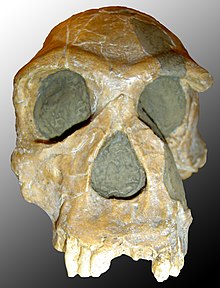Saturday, May 5, 2012
Changing Human Paleobiology
(Picture from here.)
One of the things that changes over time is our perspective on our ancestors. It wasn't so long ago that we thought of Neanderthals as stupid, shambling brutes. Now we know they may have had brains that rivaled ours, speech and red hair. Our perspective of our ancient ancestors is also undergoing a revision.
Lucy is one of our earliest relatives. She's a representative of Australopithecus afarensis from about 3.2 million yers ago. Two years ago a new species of Australopithecus, A. sediba, was discovered also in Africa. A. sediba has a brain that is more organized like a human's than others.(See here.) She also has a tool maker's hand-- a hand much more capable of using tools than other members of her genus. However, she also has a foot that is more primitive than Lucy. (See here.) A. sediba is dated to about 2 million years ago.
Human beings belong to genus Homo. Home first appears with Homo habilis 2.33 to 1.8 million years ago.Which make one wonder if there was an overlap between the origin of Homo and the existence of A. sediba. It certainly makes the origin of genus Homo more interesting. Possibly, we'll discover another member of Australopithecus that will join the bipdal gait of Lucy with genus Homo.
The rhino in the room for this discussion is what traits are derived traits that humans inherited from non-human ancestors and what humans evolved on their own.Traits that we identify as hallmarks of our humanity include bipedal gate and the human brain. A. afarensis was fully bipedal but didn't have a human brain. A. sediba had, organizationally at least, something that might have evolved into a human brain but didn't have a human foot to back it up.
Adding to that is a recent find of another Australopithecus, a contemporary of Lucy, that had more of a tree dwelling foot than Lucy did. (See here.)
Questions about. Did Lucy or another Lucy-like relative serve as the ancestor of Homo habilis and the brain organization derive separately from A. sediba? Or did A. sediba, or something like her, serve as an ancestor to Homo habilis and the foot derive separately? Or, is there a third Australopithecus species waiting to be found?
What we've been calling late derived traits are being pushed back all the time. Baboons had been shown to be able to distinguish gibberish from actual words-- an astonishing feat for a species that doesn't talk. (See here also.) Clearly, they are not determining this by the meaning of the words. Instead, they must be using some sort of statistical mechanism to detect patterns. Humans probably do the same thing. However, the lineage from which humans arose split from the baboon line thirty million years ago. Baboons
My point is the the dividing line between what an ancient genus Homo and an ancient genus Australopithecus may not have been all that great.
A new study that came out in the last few weeks looks at the number of large predators over time. These days there are only a few predators over 70 kg. But as recently as three million years ago there were many more. About two million years ago the number of large predators crashed. The study ruled out climate change or other more typical "natural" disasters. But it couldn't rule out that humans, or equivalents, might have done it.
The granularity of the time domain is broad-- 500k years. Which is problematic since if the actual date moves one way or the other genus Homo might not be responsible. If it's too early, Homo wasn't around to do the job. If it's too late then Homo was around for quite a while without making any impact.
But as I read the article, I kept remembering A. sediba. Baboons. Chimps. And all the other animals we've arrogantly claimed couldn't use tools, communicate or think.
If humans didn't do the deed there might still be other candidates.
Subscribe to:
Post Comments (Atom)




No comments:
Post a Comment